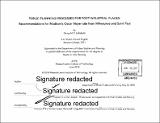| dc.contributor.advisor | Eran Ben-Joseph. | en_US |
| dc.contributor.author | Littlefield, Danya M. F | en_US |
| dc.contributor.other | Massachusetts Institute of Technology. Department of Urban Studies and Planning. | en_US |
| dc.coverage.spatial | n-us-wi n-us-mi | en_US |
| dc.date.accessioned | 2018-09-28T20:58:33Z | |
| dc.date.available | 2018-09-28T20:58:33Z | |
| dc.date.copyright | 2018 | en_US |
| dc.date.issued | 2018 | en_US |
| dc.identifier.uri | http://hdl.handle.net/1721.1/118246 | |
| dc.description | Thesis: M.C.P., Massachusetts Institute of Technology, Department of Urban Studies and Planning, 2018. | en_US |
| dc.description | Cataloged from PDF version of thesis. | en_US |
| dc.description | Includes bibliographical references (pages 89-91). | en_US |
| dc.description.abstract | Urban industrial land is dwindling in cities, becoming increasingly in danger of conversion to other uses. The shuttering of factories across the country has led many municipal planning governments to consider how industrial land can be preserved in order to maintain land dedicated to employment for residents. At the same time, market pressures on individual industrial sites have shown that this same industrial land may be able to support a wide range of uses, depending on the level of contamination and its integration with the rest of the city fabric. These dueling pressures come to a head when large, prominent industrial employers close their operations in a municipality, leaving a gap in both the local economy and in the landscape. Often redevelopment is largely private-sector endeavor, but the prominence of large industrial employers, the size of older industrial sites, the cleanup efforts required, the potential for rezoning these parcels, and the city goals that could be reflected in redevelopment of these sites inspire publicly led redevelopment planning efforts in some cases. Through case studies in Milwaukee, Wl and Saint Paul, MN, this research uncovers some of the pressures and forces that guide public land use planning and decision- making on formerly industrial land at the site level. Through analysis of the planning processes and tools used to respond to these pressures, land use planning recommendations are made for a third city: Madison, WI, where the Oscar Mayer headquarters was located from 1919 until it closed in 2017. Recommended actions for both the city-led committee and the ownership team include the use of scenario planning to model land use outcomes and measure the impact of different land uses through metrics and description; engaging community members in the strategic assessment phase of planning as soon as possible; tying employment goals directly to employment land through redevelopment performance requirements; consideration of mixed-use employment districts; and marketing the vision for the land to potential tenants and developers. | en_US |
| dc.description.statementofresponsibility | by Danya M.F. Littlefield. | en_US |
| dc.format.extent | 91 pages | en_US |
| dc.language.iso | eng | en_US |
| dc.publisher | Massachusetts Institute of Technology | en_US |
| dc.rights | MIT theses are protected by copyright. They may be viewed, downloaded, or printed from this source but further reproduction or distribution in any format is prohibited without written permission. | en_US |
| dc.rights.uri | http://dspace.mit.edu/handle/1721.1/7582 | en_US |
| dc.subject | Urban Studies and Planning. | en_US |
| dc.title | Public planning processes for post-industrial places : recommendations for Madison's Oscar Mayer site from Milwaukee and Saint Paul | en_US |
| dc.title.alternative | Recommendations for Madison's Oscar Mayer site from Milwaukee and Saint Paul | en_US |
| dc.type | Thesis | en_US |
| dc.description.degree | M.C.P. | en_US |
| dc.contributor.department | Massachusetts Institute of Technology. Department of Urban Studies and Planning | |
| dc.identifier.oclc | 1054103985 | en_US |
